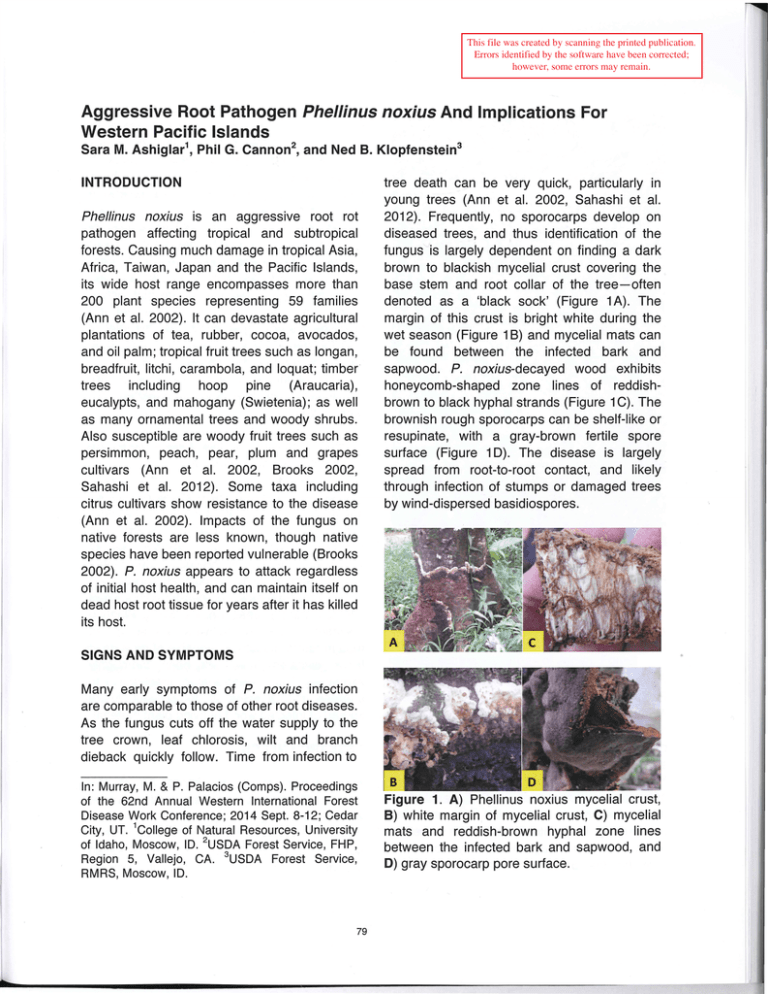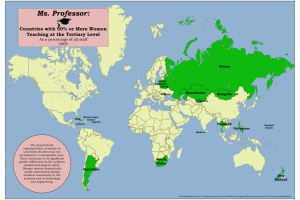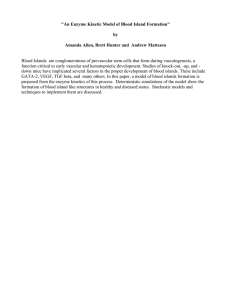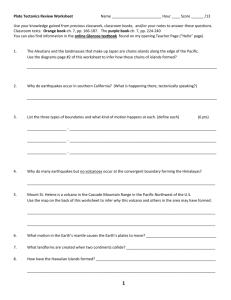Phellinus noxius Western Pacific Islands
advertisement

This file was created by scanning the printed publication. Errors identified by the software have been corrected; however, some errors may remain. Aggressive Root Pathogen Phellinus noxius And Implications For Western Pacific Islands Sara M. Ashiglar1, Phil G. Cannon 2 , and Ned B. Klopfenstein 3 INTRODUCTION Phel/inus noxius is an aggressive root rot pathogen affecting tropical and subtropical forests. Causing much damage in tropical Asia, Africa, Taiwan, Japan and the Pacific Islands, its wide host range encompasses more than 200 plant species representing 59 families (Ann et al. 2002). It can devastate agricultural plantations of tea, rubber, cocoa, avocados, and oil palm; tropical fruit trees such as longan, breadfruit, litchi, carambola, and loquat; timber trees including hoop pine (Araucaria), eucalypts, and mahogany (Swietenia); as well as many ornamental trees and woody shrubs. Also susceptible are woody fruit trees such as persimmon, peach, pear, plum and grapes cultivars (Ann et al. 2002, Brooks 2002, Sahashi et al. 2012). Some taxa including citrus cultivars show resistance to the disease (Ann et al. 2002). Impacts of the fungus on native forests are less known, though native species have been reported vulnerable (Brooks 2002). P. noxius appears to attack regardless of initial host health, and can maintain itself on dead host root tissue for years after it has killed its host. tree death can be very quick, particularly in young trees (Ann et al. 2002, Sahashi et al. 2012). Frequently, no sporocarps develop on diseased trees, and thus identification of the fungus is largely dependent on finding a dark brown to blackish mycelial crust covering the base stem and root collar of the tree-often denoted as a 'black sock' (Figure 1A). The margin of this crust is bright white during the wet season (Figure 1B) and mycelial mats can be found between the infected bark and sapwood. P. noxius-decayed wood exhibits honeycomb-shaped zone lines of reddishbrown to black hyphal strands (Figure 1C). The brownish rough sporocarps can be shelf-like or resupinate, with a gray-brown fertile spore surface (Figure 1D). The disease is largely spread from root-to-root contact, and likely through infection of stumps or damaged trees by wind-dispersed basidiospores. SIGNS AND SYMPTOMS Many early symptoms of P. noxius infection are comparable to those of other root diseases. As the fungus cuts off the water supply to the tree crown, leaf chlorosis, wilt and branch dieback quickly follow. Time from infection to In: Murray, M. & P. Palacios (Comps). Proceedings of the 62nd Annual Western International Forest Disease Work Conference; 2014 Sept. 8-12; Cedar City, UT. 1College of Natural Resources, University of Idaho, Moscow, ID. 2 USDA Forest Service, FHP, Region 5, Vallejo, CA. 3 USDA Forest Service, RMRS, Moscow, ID. 79 Figure 1. A) Phellinus noxius mycelial crust, B) white margin of mycelial crust, C) mycelial mats and reddish-brown hyphal zone lines between the infected bark and sapwood, and D) gray sporocarp pore surface. introduction sites. For example on the Northern Mariana Islands of Saipan and Rota, Hodges and Tenorio (1984) postulate that P. noxius was introduced to a port of entry through infected plants or wood. This could have happened after World War II when extensive relief supplies were delivered to the Rota airport. Infected wood in packing crates or infected agricultural plants may have allowed the fungus to escape onto these islands from these airport infection foci. The authors of this proceedings paper also speculate that within island, and island-to-island transport of the host species breadfruit, known as "the staff of life" for many Pacific island residents, may have accelerated the spread of P. noxius. Suckers of this very vulnerable species are commonly collected and transported for propagation. Figure 2. Native plant used as local remedy to treat Phellinus noxius in Pohnpei. PHELLINUS NOXIUS AND THE PACIFIC ISLANDS P. noxius is considered non-native to many Pacific islands, but this is not well documented. Although it has been found to infect native trees in this region, the fungal pathogen is primarily associated with non-native agricultural crops and areas disturbed by humans (Brooks 2002, Hodges and Tenorio 1984; also see Ann et al. 2002, Sahashi et al. 2012 for more discussion on invasive distribution). Its establishment on western Pacific islands is thought to be fairly recent and thus far the damage is only moderate at Further expansion of this fungus could be detrimental to uninfected areas due to its aggressive nature, economic impact, and wide host range. There are few practical options for management of this disease due to its longterm survival in the soil and on wood, high application cost and low effectiveness of fungicides, insufficient testing of biocontrol agents, and difficulty of cultural applications such as stump removal or long-term flooding of infected areas (Sahashi et al. 2012). Planting resistant species or cultivars is one option, though resistant cultivars capable of growing iri these climates have not been thoroughly examined. The current primary mechanism to manage this species is to prevent future spread of infected wood or living plant material. RESEARCH NEEDS P. noxius must be monitored across the western Pacific, eastern Asia, and Australia, while preventing its spread to uninfested islands (i.e., to our knowledge there have been no reports of P. noxius on the Hawaiian Islands, the Marshall Islands, Caroline Islands, 80 French Polynesia, and Cook Islands, to name a few island systems with comparable climatic conditions and susceptible host species). Extensive scientific and/or citizen surveys should be conducted on each island using input from pathologists, local forestry staff, and villagers. Distribution maps for each island should be created, along with approximated size of infection foci. Isolates should be collected and field trials conducted to determine the most aggressive isolates of P. noxius as well as identify locally important susceptible and resistant host species/cultivars. Practical local remedies such as placing mangrove mud or other native plant extracts (e.g. Figure 2) on infected hosts should also be tested under controlled settings to evaluate their effectiveness. Eventually island-wide P. noxius management plans incorporating the above-mentioned information should be developed. In addition to surveys, molecular research on the population genetics of this fungus would be helpful in conveying the spread of P. noxius on the Pacific Islands. The molecular differentiation of genotypes combined with a literature review and local oral accounts would reveal how the species has travelled from island to island, and which areas of the world are more at risk to future introduction. Finally, in order to reduce future spread of P. noxius, suitable habitat for this species must be delineated. While it has a large host range that spans across tropical and temperate 81 species, P. noxius appears susceptible to cold temperatures and has not yet been found in high elevations of tropical areas or in higher latitudes with cold winters. Modeling both current and future climate habitat for P. noxius would significantly assist in prioritizing which islands and other areas of the world should be most protected from the introduction of this species (for more details, see: Cannon 2015). REFERENCES Ann P.-J., T.-T. Chang, and W.-H. Ko. 2002. Phellinus noxius brown root rot of fruit and ornamental trees in Taiwan. Plant Disease 86:820-826. Brooks F.E. 2002. Brown root rot disease in American Samoa's tropical rain forests. Pacific Science 56:377-387. Cannon, P. 2014. Forest Pathology in Yap, Palau, Pohnpei, Kosrae, Guam and Saipan, Sept. 2013. Trip Report. USDA Forest Service, State and Private Forestry, Forest Health Protection, Region 5. Vallejo, CA. 90 p. Hodges C.S. and J.A. Tenorio. 1984. Root diseases of Delonix regia and associated tree species in the Mariana Islands caused by Phellinus noxius. Plant Disease 68:334-336. Sahashi N. and others. 2012. Brown root rot of trees caused by Phellinus noxius in the Ryukyu Islands, subtropical areas of Japan. Forest Pathology 42:353-361.







